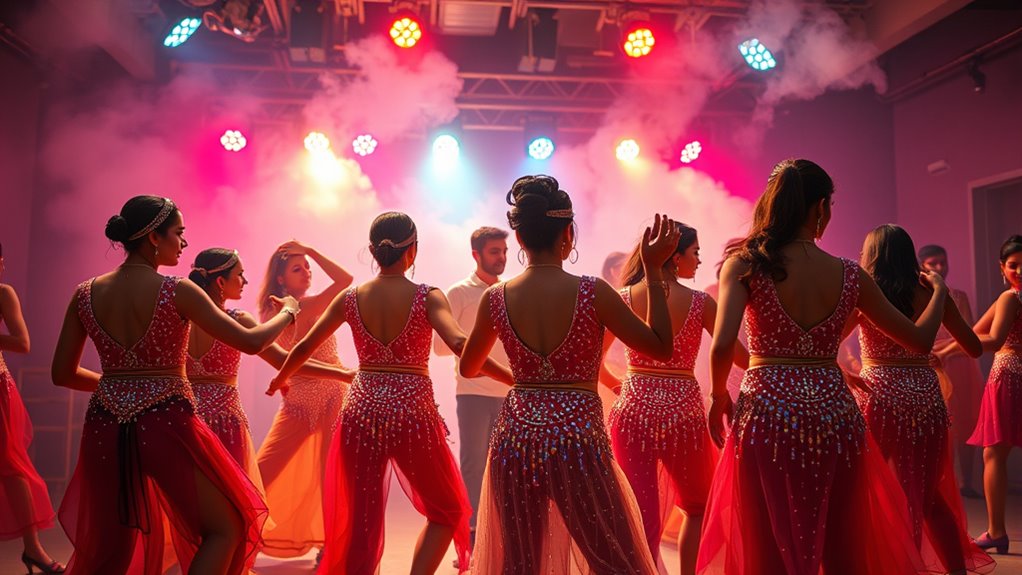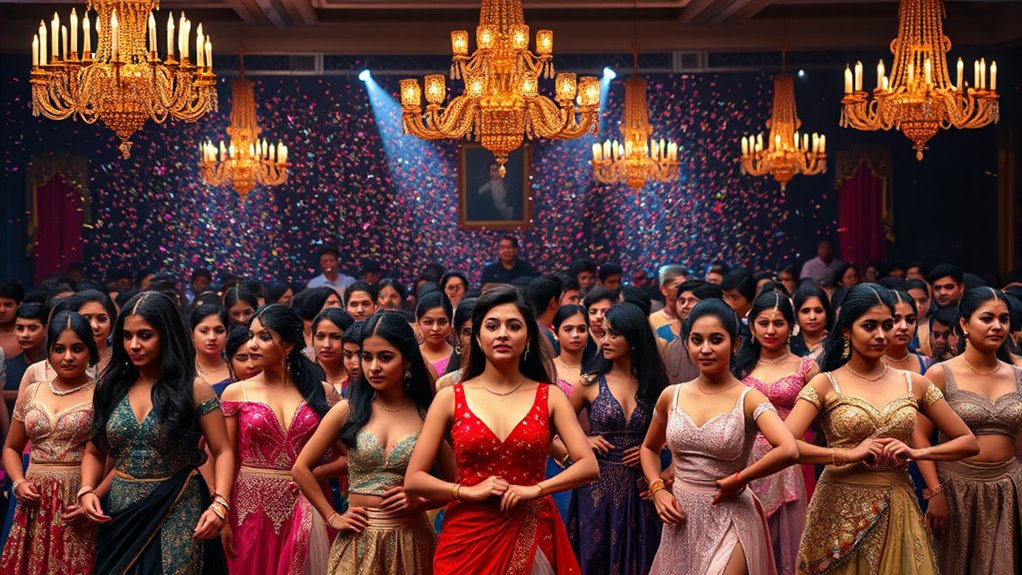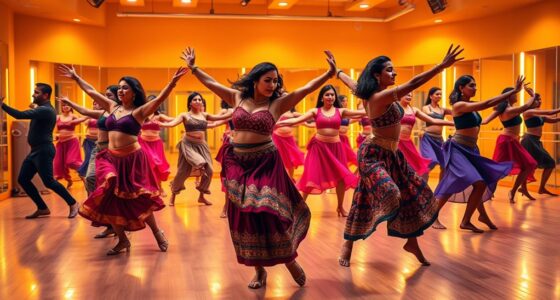As a Bollywood backup dancer, you endure long, demanding hours of rehearsals and shoots, often lasting 12 to 15 hours a day, with unpredictable pay and tough conditions. Despite your essential role in creating the spectacular dance scenes, industry norms often overlook your artistry, paying little credit or respect. Steering through this challenging world requires skill, resilience, and passion—if you’re curious about how dancers keep their careers afloat and find new opportunities, keep exploring more.
Key Takeaways
- Bollywood backup dancers perform long, strenuous hours with unpredictable pay, often working 12-15 hour days during shoots.
- They undergo formal training and audition processes, yet face industry stereotypes and limited recognition.
- Income is irregular and delayed, with many supporting families and managing high living costs in Mumbai.
- Career longevity averages around 10 years, with challenges transitioning into stable roles like choreography or teaching.
- Despite their vital role in dance spectacles, they remain undervalued as “extras” in the industry.
The Daily Routine and Earnings of Bollywood Backup Dancers

Bollywood backup dancers often start their long workdays early, working 12 to 15 hours during song shoot days, especially when multiple takes extend on-set hours. You spend your day rehearsing and then filming, often enduring unpredictable schedules with long stretches of work followed by downtime. Rehearsals are separate from shoot days and can last several hours, preparing you for the demanding filming process. During shoot days, you earn around ₹4,000–₹4,500 per day, but payment isn’t guaranteed and doesn’t always cover extra hours. Your income varies depending on projects, with fewer opportunities now than before. Many dancers struggle financially, supporting families back home and coping with Mumbai’s high living costs. Irregular pay and job insecurity make budgeting difficult, adding constant stress to your routine. With industry trends moving away from large dance ensembles, the demand for background dancers has further decreased, making steady work even more scarce. Additionally, the physical demands of dance can lead to injuries and exhaustion, impacting long-term career sustainability.
Pathways Into Bollywood: Training and Early Careers

To break into the world of Bollywood dance, aspiring performers often start by enrolling in prestigious training institutions like the National Institute of Kathak Dance, Shiamak Davar Dance Academy, or Terence Lewis Professional Training Institute. These schools provide extensive courses that cover dance fundamentals, stage presence, and choreography, helping you develop solid technique and artistry. Formal training is essential for building a strong foundation for backup roles, blending practical skills with creative performance. Many dancers also pursue coaching and mentoring from professional choreographers, gaining valuable feedback and industry insights. Earning recognized qualifications through dance exams can boost your credibility. Early in your career, auditions for backup dancer roles in films, shows, or videos are key. Participating in reality dance competitions can also open doors and build your visibility in the industry. Additionally, training programs often include opportunities for hands-on teaching practice and exposure to industry professionals, which can significantly enhance your career prospects. Engaging with industry support networks can provide additional guidance and opportunities for growth. Developing a strong dance technique through consistent practice and training can further improve your chances of success in this competitive field, especially when complemented by understanding the importance of self-marketing within the industry. Moreover, staying updated on trending dance styles can help dancers remain relevant and appealing to choreographers and casting directors.
Industry Dynamics and Changing Preferences

The role of background dancers in Bollywood has evolved considerably over the years, reflecting shifts in industry practices and audience preferences. Once seen mainly as extras, they now contribute substantially to the visual spectacle of dance numbers, though many still lack long-term job security. As choreography styles become more intricate and technology advances, the demand for skilled dancers in contemporary, fusion, and traditional forms has increased. Social media platforms like TikTok boost dancers’ visibility, helping them gain recognition beyond the film sets. Industry norms are shifting, with more efforts to treat dancers as respected artists and provide financial support through trusts and aid during crises. Many dancers now gain recognition through social media platforms, which have become crucial for their visibility and career growth. These changes highlight the industry’s recognition of background dancers’ importance in shaping Bollywood’s dynamic, evolving dance culture. Additionally, the industry’s evolving practices now emphasize fairer treatment and opportunities for these performers, reflecting a broader shift towards inclusivity and respect for their craft. The integration of electric-powered dance productions and innovative choreography techniques further demonstrates the industry’s adaptation to modern trends and technological advancements. Moreover, the incorporation of AI-driven choreography planning is beginning to influence how dance routines are conceptualized and executed, opening new avenues for creativity and efficiency. Furthermore, incorporating payment processing systems can facilitate smoother financial transactions for dancers, ensuring timely payments and better financial management. Additionally, embracing digital marketing strategies can help dancers build personal brands and expand their reach in the competitive entertainment landscape.
Challenges Faced by Background Performers

As a background dancer, you often deal with unstable pay and unpredictable income, making it hard to plan your future. Your career can be short-lived, with limited opportunities to grow or gain recognition in the industry. Despite your hard work, you might feel overlooked and undervalued, which adds to the challenges you face daily. Their earnings are often as low as Rs 4,000-4,500 per day, which makes it difficult to sustain a livelihood over time. Additionally, the lack of a structured track development process can hinder your chances of advancing or being noticed for bigger roles. Having a clear financial plan and understanding investment options can help dancers build a more secure future. Regular use of glycolic acid products in skincare routines can help improve skin texture and radiance, which might boost confidence. Moreover, the absence of professional support systems can leave dancers feeling isolated and without guidance on career progression. Leveraging training and skill enhancement opportunities can further open doors to more prominent performances and recognition.
Financial Instability Issues
Financial instability remains a major challenge for background dancers in Bollywood. Your income varies greatly, with daily earnings around ₹4,500 for a song, and rehearsals paying just ₹750. Payments are often delayed over a month, adding to uncertainty. Since you work only about 10-12 days monthly, your overall income fluctuates, and there’s no paid leave during downtime. The table below highlights key financial issues:
| Issue | Impact | Example |
|---|---|---|
| Irregular payments | Income uncertainty, cash flow problems | Payments delayed 1+ month |
| Limited workdays | Reduced monthly earnings | 10-12 days/month |
| No paid leaves | No income during inactive periods | No pay during breaks |
| Dependence on big projects | Income spikes, inconsistent flow | Big productions bring more pay |
This unstable financial landscape leaves many dancers constantly worried about meeting basic needs. Additionally, the lack of financial planning resources makes it harder for dancers to manage their fluctuating income effectively. Developing better income management strategies could help dancers stabilize their earnings and plan for future expenses more securely. Furthermore, establishing access to financial resources could provide crucial support during lean periods. Understanding the various merchant services options available can also assist dancers in managing their earnings efficiently through secure and flexible payment solutions. Recognizing the importance of financial literacy can empower dancers to make informed decisions about their earnings and savings.
Limited Career Longevity
Industry preferences are shifting quickly, making it hard for background dancers to build lasting careers. As industry standards evolve, directors now favor younger, fitter, and “good-looking” performers, reducing opportunities for experienced dancers. Auditions are now mandatory, making it tougher for older dancers to secure work. Casting choices prioritize “new faces,” often overlooking talent and experience. Limited job stability and the shrinking pool of opportunities also contribute to the difficulty in maintaining a long-term career. You face a limited career span—about 10 years on average—and find it difficult to transition into stable roles like choreography. Opportunities for advancement are rare, and attempts at shifting careers are risky due to industry biases. Seasonal work, irregular schedules, and fluctuating demand add to the instability, making it challenging to sustain a long-term career in Bollywood’s dance industry. Furthermore, the industry’s preference for youth often leads to a lack of mentorship or opportunities for seasoned performers to stay relevant. Additionally, the market volatility impacts the availability of consistent work, further complicating career longevity for background dancers.
Lack of Industry Respect
Background dancers often go unnoticed and undervalued, despite their essential role in making Bollywood song sequences vibrant and memorable. Industry perception labels them as “extras,” not artists, which minimizes their talent and contribution. Many feel their work is taken for granted, with little recognition or credit in films. They’re seen as interchangeable, with no regard for their unique skills. This lack of respect shows in delayed payments, poor working conditions, and little job security. Casting favors certain looks, often sidelining talented dancers who don’t fit narrow standards. Female dancers are increasingly preferred, making it harder for others to find work. Overall, industry stereotypes and superficial standards diminish their worth, leaving background performers fighting for acknowledgment and dignity in a space that often dismisses their artistry. This marginalization persists despite the critical support they provide to the overall visual appeal of Bollywood productions.
Cultural Significance and Global Influences

Bollywood dance has transcended Indian borders to become a vibrant symbol of cultural exchange and global influence. You see it in dance schools and community groups worldwide, promoted by the Indian diaspora. Bollywood festivals draw diverse fans and dancers, showcasing its international reach. Choreographers like Nakul Dev Mahajan have helped popularize this style beyond India’s borders. International backup dancers—Americans and Europeans alike—seek steady work and artistic growth in Bollywood.
- Fusion of Indian, Western, Latin, and global dance styles in choreography
- Hybrid costumes and routines reflecting international trends
- Dance sequences that challenge traditional gender roles and social norms
- Cross-cultural collaborations deepen global appreciation for Bollywood dance
Transitioning to New Careers After the Spotlight

When your time on stage ends, you’ll need to explore new career opportunities that leverage your skills and experience. Moving on can be challenging, but your discipline, creativity, and teamwork open doors in fields like teaching, choreography, or entrepreneurship. With the right preparation, you can turn your spotlight moments into a foundation for success behind the scenes.
From Stage to Studio
Shifting from the limelight can be challenging for backup dancers, as their careers often have a limited shelf life and face diminishing opportunities. Many seek new paths within the industry or beyond. You might find yourself:
- Teaching dance to children or hobbyists, sharing your expertise.
- Moving into choreography or production roles behind the scenes.
- Transitioning to unrelated service sector jobs like driving or hospitality.
- Launching your own studio or entertainment venture to craft your future.
These options require adapting your skills and mindset, often amidst financial pressures and identity shifts. Despite industry biases, exposure through reality shows or social media can open new doors. While long-term stability remains elusive, diversifying your talents helps you stay resilient in a changing landscape.
New Career Opportunities
Switching to a new career can be challenging, especially after years of performing on stage or in music videos. You might overestimate how long you’ll dance professionally or how much you’ll earn afterward, which can cause financial stress. Being fully prepared makes a difference—diversifying your skills and gaining formal or informal training can open new doors. Many former dancers find success in choreography, teaching, fitness, wellness, or even starting their own dance-related businesses. Networking and continuous learning are essential for finding opportunities in these fields. While income and stability can vary, careful financial planning, savings, and entrepreneurial ventures can provide security. Ultimately, a well-planned *progression* allows you to continue expressing your creativity and find fulfillment beyond the spotlight.
Frequently Asked Questions
How Do Bollywood Backup Dancers Sustain Themselves Financially Long-Term?
You sustain yourself long-term by diversifying your income sources and staying adaptable. Building your skills in choreography or teaching can provide additional revenue, while networking helps you find more work. Moving to different locations or exploring alternate careers during downtime keeps your finances steady. Staying updated with industry trends and continuously improving your craft guarantees you remain relevant, even as demands change. This proactive approach helps you navigate financial ups and downs sustainably.
What Are the Specific Skills Required to Become a Successful Backup Dancer?
To succeed as a backup dancer, you need strong physical skills like stamina, flexibility, and agility, allowing you to perform complex moves seamlessly. You should master basic Bollywood dance steps, stay synchronized with the group, and quickly learn new choreographies. Professional skills like punctuality, teamwork, and resilience matter, along with confidence and a passionate attitude. Focus on continuous improvement and maintaining discipline to stand out and thrive in this competitive industry.
How Has Digital Media Impacted the Visibility of Background Dancers?
Digital media has markedly boosted your visibility as a background dancer. Platforms like YouTube, Instagram, and TikTok let you showcase your skills to a global audience, making it easier to get noticed by industry professionals. Viral dance videos and trending challenges highlight your talent, opening doors for international opportunities. With consistent online presence, you can build a fanbase, attract collaborations, and elevate your career beyond traditional Bollywood circles.
Are There Any Support Systems or Unions for Backup Dancers in India?
You might think backup dancers have a robust support system, but the reality is quite different. The Cine Dancers Association (CDA) is the main union, though internal disputes have stalled its functions since 2019. Despite efforts like wage negotiations and social media campaigns, many dancers face delayed payments and job insecurity. External support from industry figures and social organizations is growing, but all-encompassing, reliable support remains elusive for now.
What Are the Health Risks Associated With a Dancer’S Career in Bollywood?
You face several health risks in your Bollywood dance career, including musculoskeletal injuries like sprains, strains, and tendinopathies, especially in your knees, ankles, and back. Overuse from repetitive movements and fatigue increases your injury chances. Stress from demanding schedules and performance pressure worsens your condition. Without proper warm-up, stretching, or recovery, chronic issues like back pain and spinal problems can develop, impacting your longevity and quality of life.
Conclusion
Did you know that Bollywood backup dancers often work over 12 hours a day yet earn just a fraction of lead stars? Despite their demanding schedules and modest pay, they bring energy and passion to every performance, making them unsung heroes of the dance floor. Their dedication keeps the industry vibrant and diverse. Next time you watch a Bollywood hit, remember the talented dancers behind the scenes who make it all come alive.









